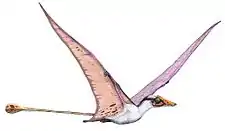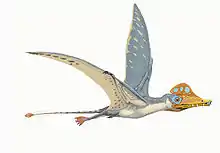Rhamphinion
Rhamphinion (meaning "beak nape"; Greek rhamphos, "beak" is a common part of "rhamphorhynchoid" names, and the remains of this animal came from the rear of the skull, i.e. "nape" or inion) is a genus of pterosaurs from the Sinemurian-mid Pliensbachian-age Lower Jurassic Kayenta Formation of northeastern Arizona, United States. The type species is R. jenkinsi.
| Rhamphinion | |
|---|---|
| Scientific classification | |
| Kingdom: | Animalia |
| Phylum: | Chordata |
| Order: | †Pterosauria |
| Clade: | †Dimorphodontia (?) |
| Genus: | †Rhamphinion Padian, 1984 |
| Species: | †R. jenkinsi |
| Binomial name | |
| †Rhamphinion jenkinsi Padian, 1984 | |
Discovery
The type species, Rhamphinion jenkinsi, was described and named in 1984 by Kevin Padian, based on holotype MNA V 4500, a partial skull including the occipital region, a partial left jugal, a fragment of the lower jaw including two preserved teeth and the impression of a third, and one other fragment that could not be identified. The specific name honors the discoverer of the fossil, Farish Alston Jenkins Jr. At the time, it was the oldest known pterosaur specimen from the Western Hemisphere (now overtaken by Caelestiventus). Padian did not assign it to any family or suborder within Pterosauria, but did note that the jugal was unlike that of pterodactyloids, and so may have belonged to a "rhamphorhynchoid", i.e. a basal pterosaur. A bone from the wing of another pterosaur from the same formation, found in 1981, may have also belonged to a "rhamphorhynchoid", with a wingspan of about 1.5 m (4.9 ft).[1] Peter Wellnhofer agreed that a "rhamphorhynchoid" identity was very likely,[2] but David Unwin was more hesitant to classify its fragmentary remains in The Pterosaurs: From Deep Time, noting it only as a "possibly valid species of uncertain relationships."[3] A recent cladistic analysis of Jidapterus recovers Rhamphinion as a close relative of Dimorphodon and Parapsicephalus.[4]
References
- Padian, K. (1984). Pterosaur remains from the Kayenta Formation (?early Jurassic) of Arizona Archived 2007-09-27 at the Wayback Machine. Palaeontology 27(2):407-413. [if you get an I/O error message, push "OK" and it should work]
- Wellnhofer, Peter (1996) [1991]. The Illustrated Encyclopedia of Pterosaurs. New York: Barnes and Noble Books. p. 78. ISBN 0-7607-0154-7.
- Unwin, D.M. (2006). The Pterosaurs: From Deep Time. Pi Press:New York, p. 273. ISBN 0-13-146308-X.
- Wu W-H, Zhou C-F, Andres B (2017) The toothless pterosaur Jidapterus edentus (Pterodactyloidea: Azhdarchoidea) from the Early Cretaceous Jehol Biota and its paleoecological implications. PLoS ONE 12(9): e0185486. https://doi.org/10.1371/journal.pone.0185486
External links
- Rhamphinion in The Pterosauria
- Rhamphinion in Dinodata.de (in German)














